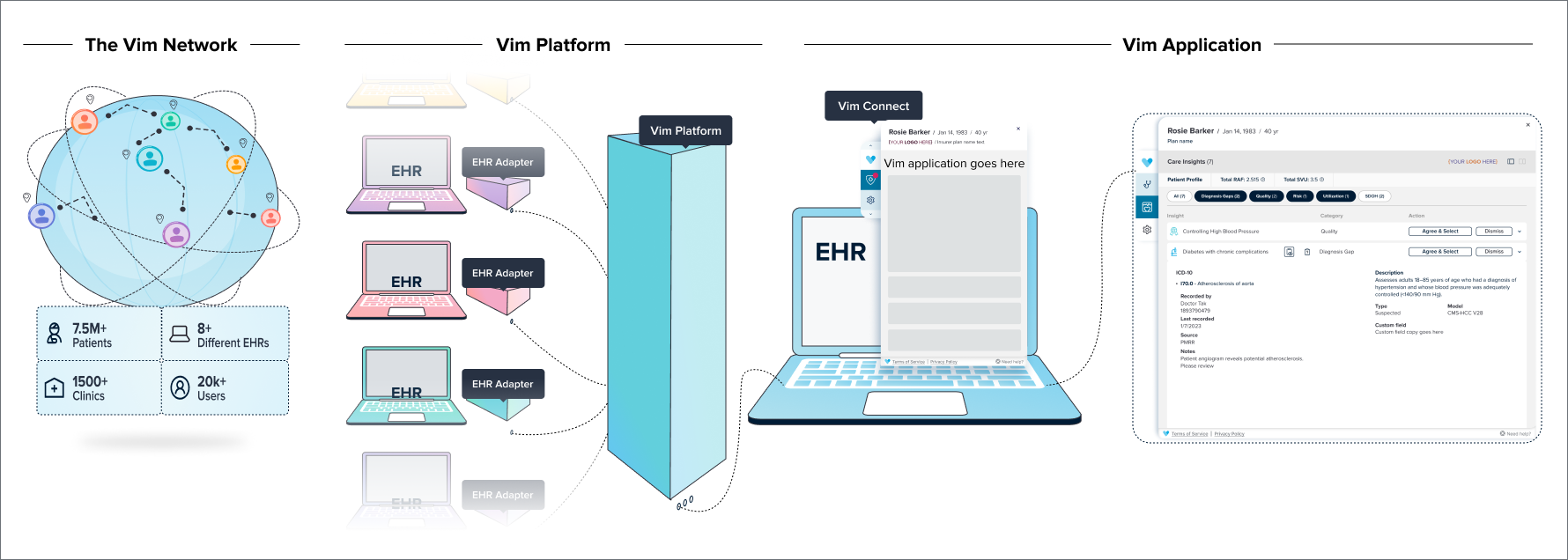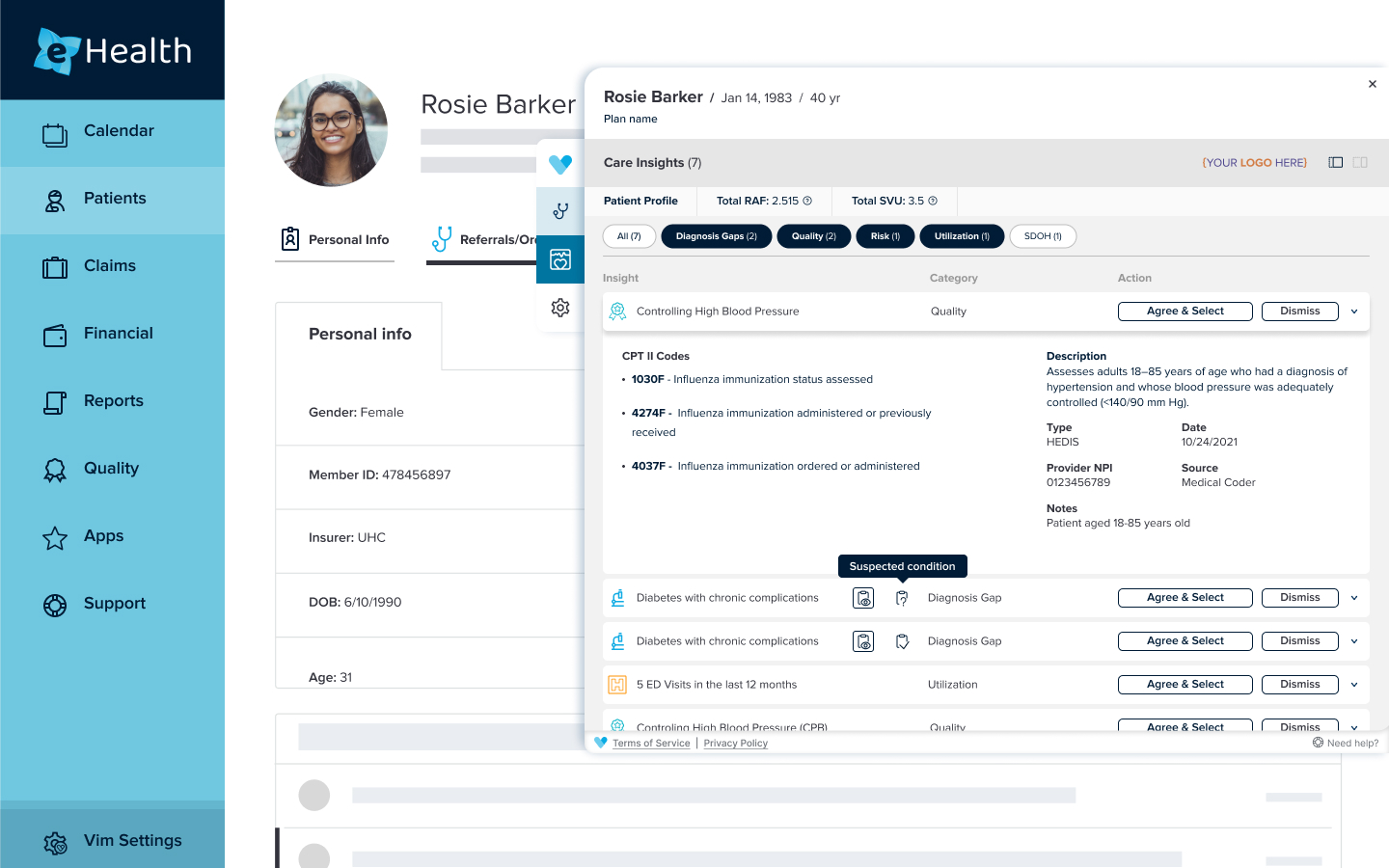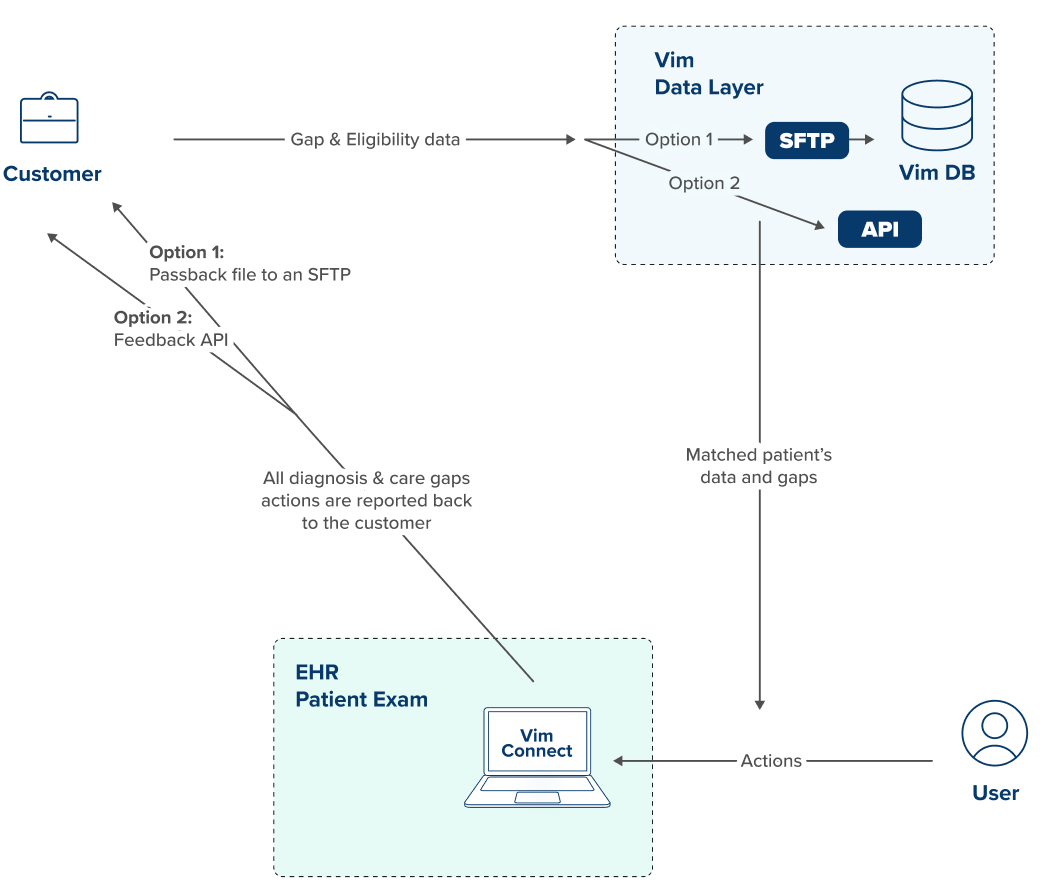Appearance
Vim Overview
What is Vim?
Vim connects healthcare organizations to providers at the point of care by embedding actionable clinical insights directly into supported electronic health record (EHR) workflows. Our goal is to help providers take informed action during the encounter—without leaving the EHR.
This document explains how you can send your data to Vim, via file or API, so it can be surfaced meaningfully inside the EHR outlining the key concepts, requirements and configurations to support integration.
How Vim Connect Works
Vim Connect is the lightweight desktop application that powers Vim’s presence inside the EHR. Once installed by the provider organization, it enables Vim applications to appear contextually within the EHR - without requiring complex system integration or workflow changes.
Vim surfaces patient-specific insights at the point of care by integrating with data sources through either API or file-based connections. The submitted data is matched in real time to the patient currently in context, and relevant insights are displayed directly in the EHR interface.
Through Vim’s back office, we configure which practices and provider organizations are authorized to access the data. This ensures insights are only displayed where appropriate and aligned with integration agreements.

Supported EHRs
Vim currently supports the following EHRs:
- AthenaHealth
- DrChrono
- eClinicalWorks (v11.52+)
- Elation
- NextGen Enterprise
- Office Ally EHR 24/7
- Practice Fusion
- TouchWorks
- MDLand
Actively working on:
- eMedicalPractice
- eMDs
New EHRs are added based on partner demand. If you don’t see your EHR listed, please contact us.
Vim Applications Overview
Care Insights
Care Insights is Vim’s core application that helps providers make informed, real-time decisions by surfacing relevant clinical and operational information directly within the EHR. It minimizes context switching, reduces manual chart reviews, and supports efficient documentation and care gap closure.
Insights are clearly categorized (e.g., Diagnosis Gaps, Risk, Quality, SDoH) and can be filtered based on role or relevance. Providers can resolve gaps automatically through in-EHR behavior or close them manually within the applicatation while capturing context, such as the action taken (e.g., referral sent), dismissal reason, or notes. Relevant codes are written directly into the EHR in real time and shared with the data source, enabling providers to complete tasks quickly, with minimal disruption to their workflow.

Vim’s offering includes additional applications, as well as third-party applications, for more information, contact a Vim representative.
How Data Flows Through Vim
The following steps outline how Vim processes and presents care insights within the EHR workflow:
- Patient Detection - Vim identifies the patient currently in context within the EHR
- Patient Matching - Vim extracts patient demographic data from the EHR and initiates a matching process to confirm whether the patient in context exists in the data source
- Insight Retrieval - For eligible patients, Vim retrieves the relevant care insights associated with that individual
- Insights In-EHR Display - Insights are presented directly within the EHR interface during the encounter
- User Action - Providers may take action on presented insights; Vim documents the selected codes directly in the EHR encounter
- Reporting Back to the Data Source - Vim transmits recorded actions and outcomes back to the data source to support tracking, analysis, and downstream use

Patient Matching Mechanism
To ensure that patient-specific data is displayed accurately and securely, Vim uses a multi-layered matching process for the file based integration that compares demographic and identifier fields from the EHR with records provided by the data source. Matching is based on the following required demographic fields:
- First name
- Last name
- Date of birth And at least one of the following identifiers:
- EHR Identifier (e.g., MRN)
- Health Plan Identifier (e.g., Member or Subscriber ID)
- Zip code
While only one identifier is required, providing more complete and consistent data improves match accuracy and reduces the likelihood of missed matches.
Vim applies multiple matching strategies in parallel, using both exact and fuzzy logic to account for minor discrepancies—such as formatting differences, letter casing, or common name variations. If no method produces a confident match, the insight is withheld to prevent misidentification
In API-based integrations, the data source is responsible for matching the patient on their side. Vim sends patient identifiers to the data source, which then returns any matching insights if the patient is found.
Core Data Entities
Vim relies on two core identifiers to ensure consistent data integrity and functionality across the platform:
- Unique Patient ID - This ID must uniquely and consistently identify each patient across all records shared with Vim. It is used to group and present patient-specific insights accurately and to support downstream logic such as billing or writeback.
- Unique Insight/ Gap ID – Each individual insight/ Gap must have a stable, unique identifier. This enables reliable tracking, filtering, resolution history, and undo functionality within the application.
These identifiers must remain stable throughout the calendar year. Changing them mid-cycle may result in duplicate displays, gaps reappearing after being resolved, or disruption to billing and analytics processes.
If you are unable to generate stable IDs within your system, please contact your Vim integration lead for guidance on best practices.
